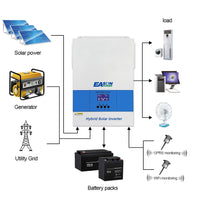Unlock the Power of the Sun: Essential Insights into Solar Charge Controllers You Can't Miss!
As the world shifts towards sustainable energy solutions, solar power has emerged as a frontrunner in renewable energy. Central to optimizing solar energy systems are solar charge controllers, devices that manage the energy flow from solar panels to batteries. These controllers not only ensure efficient energy storage but also protect your battery from overcharging and damage. With an increase in homeowners seeking to harness solar energy, understanding the significance of durable solar charge controllers becomes paramount. This article will guide you through the essential features, benefits, and specifications of these controllers, empowering you to make an informed purchasing decision for your home solar setup.

Understanding Solar Charge Controllers
Solar charge controllers are essential components in solar energy systems, acting as the intermediary between solar panels and batteries. Their primary function is to regulate the voltage and current coming from the solar panels to ensure that batteries are charged efficiently without being overcharged. There are mainly two types of solar charge controllers: Pulse Width Modulation (PWM) and Maximum Power Point Tracking (MPPT). PWM controllers are simpler and less expensive, making them suitable for smaller systems or off-grid applications. In contrast, MPPT controllers are more advanced, maximizing energy harvest by adjusting the electrical operating point of the modules. For homeowners looking to optimize their solar energy usage, understanding the differences between these types is crucial in determining which controller best suits their energy needs.
Key Features to Look For
When investing in a solar charge controller, several key features can significantly influence its durability and effectiveness. First, consider the load control capabilities, which allow the controller to manage the energy supply to connected devices, thus preventing battery drain. Temperature compensation is another vital feature; it adjusts the charging voltage based on the battery's temperature, optimizing performance and extending battery life. Additionally, having an LCD display for real-time monitoring can be incredibly beneficial, providing insights into system performance and battery health at a glance. Finally, over-voltage and over-current protection are critical to preventing damage to your solar system and ensuring safety. These features collectively contribute to a robust and reliable solar charge controller, making it a worthy investment for any home solar system.
Benefits of Using Durable Solar Charge Controllers
Investing in a durable solar charge controller offers numerous benefits that extend beyond mere energy management. One significant advantage is the enhanced lifespan of your batteries; by preventing overcharging and deep discharging, these controllers help maintain optimal battery health. Furthermore, they improve energy efficiency by maximizing the amount of energy stored and used, which can lead to lower energy bills over time. In the long run, this cost-effectiveness is complemented by the environmental impact of utilizing renewable energy sources, which reduces reliance on fossil fuels. A friend of mine, who recently set up a solar energy system at home, reported significant savings on electricity bills within just a few months, attributing much of this success to the durable solar charge controller he chose. By making a smart investment in these devices, homeowners can enjoy both financial and ecological benefits.
Specifications to Consider Before Purchase
Before making a purchase, potential buyers should consider several key specifications to ensure they choose the right solar charge controller for their needs. First, voltage compatibility is crucial; the controller must match the voltage of the solar panels and batteries in your system. Next, the current rating is important, as it determines how much current the controller can handle safely. Additionally, consider the system size and scalability; a controller that can accommodate future expansions may be a wise choice for those planning to add more solar panels or batteries later on. Finally, warranty and customer support are essential factors that can provide peace of mind, ensuring that you have assistance if any issues arise. Taking these specifications into account will help you select a controller that meets your current and future solar energy needs.
Maximizing Your Solar Energy Investment
Choosing the right solar charge controller is a critical step in maximizing the benefits of your home solar energy system. By understanding the essential features, benefits, and specifications outlined in this article, you can make an informed decision that enhances your solar energy investment. As the demand for renewable energy continues to grow, integrating a durable solar charge controller in your system can lead to significant long-term savings and contribute positively to the environment. Empower yourself with knowledge and unlock the full potential of solar energy for your home!


